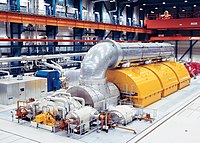
Photo from wikipedia
Understanding the water use of power production is an important step to both a sustainable energy transition and an improved understanding of water conservation measures. However, there are large differences… Click to show full abstract
Understanding the water use of power production is an important step to both a sustainable energy transition and an improved understanding of water conservation measures. However, there are large differences across the literature that currently present barriers to decision making. Here, the compiled inventory of the blue water use of power production from existing studies allowed to uncover the characteristics of water use and to investigate current uncertainties. The results show that photovoltaics, wind power, and run-of-the-river hydropower consume relatively little water, whereas reservoir hydropower and woody and herbaceous biomass can have an extremely large water footprint. The water consumption of power production can differ greatly across countries due to different geographic conditions. Only a few studies provided the values for the influencing factors of water use, such as the capacity factor. Values that are reported came mainly from assumptions and other literature rather than direct measurement. Omitting a life cycle stage may lead to significant underestimations. Water scarcity is attracting more attention, but the few existing results are not useable for a regional comparison due to data gaps and inconsistent measurements. In the future, a clear and detailed definition of the water footprint and system boundary of power production is essential to improving comparisons and energy systems modelling. © 2019 The Authors
Journal Title: Renewable and Sustainable Energy Reviews
Year Published: 2019
Link to full text (if available)
Share on Social Media: Sign Up to like & get
recommendations!